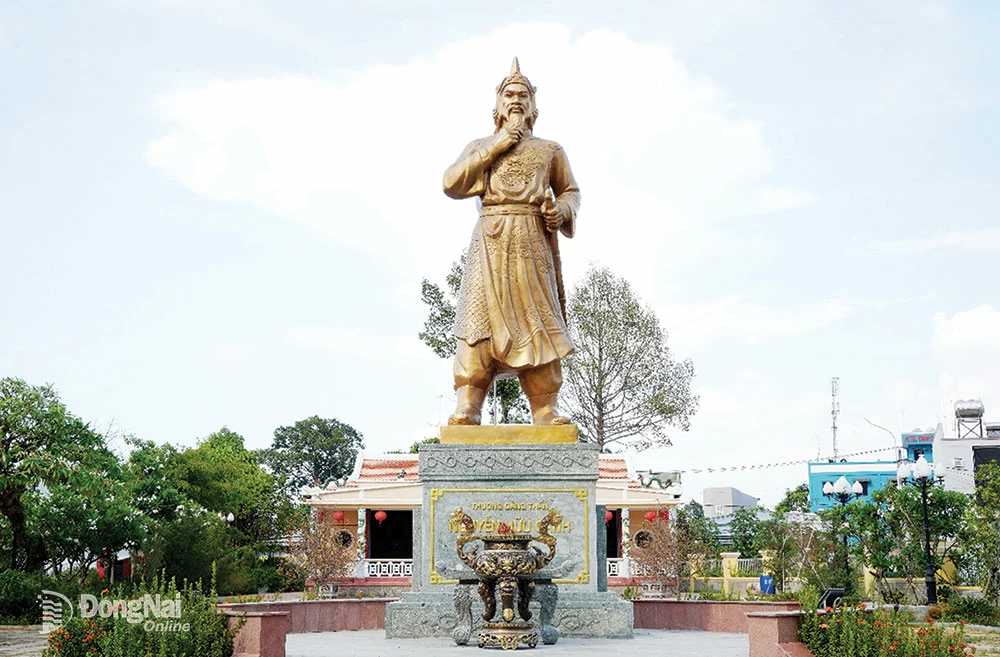 |
| Statue of Le Thanh Hau Nguyen Huu Canh at Binh Kinh communal house (Hiep Hoa ward, Bien Hoa city). Photo: Van Thanh |
These days, many places in the Southern region are preparing for the 325th death anniversary (1700-2025) of Le Thanh Hau Nguyen Huu Canh with all their respect and nostalgia. At the temple of the Supreme God Nguyen Huu Canh on Pho Island, the People's Committee of Bien Hoa City and the Temple's Board of Trustees are urgently preparing for the death anniversary on the 16th day of the 5th lunar month.
One Sunday morning, we invited each other to the temple to burn incense for Mr. Nguyen Huu Canh. When we arrived, we met Mr. Nguyen Trung Cang - who has served Mr. Nguyen Huu Canh for decades and is currently the Head of the Temple's Board of Priests. After burning incense, Mr. Cang invited us to sit at the wooden table and drink tea and happily told us stories about Mr. Nguyen Huu Canh, showing us valuable books about his biography and achievements, especially the book Le Thanh Hau Nguyen Huu Canh (1650-1700) with the work of enlightening the South of Vietnam in the late 17th century by Nhu Hien - Nguyen Ngoc Hien, reprinted for the first time by Dong Nai Publishing House in 1995.
The book is only 300 pages long, but it is clearly a serious and valuable research work. The author writes with all the respect of a descendant of the Nguyen family towards his ancestors and with the precious responsibility of a historical restorer. Not only by using documents already in the country's historical treasure, how much respect is it when the author and his relatives invest a lot of time and effort to carry out the work of tracing the past, traveling everywhere to find the homeland of Le Thanh Hau Nguyen Huu Canh in Quang Binh , to places where he was present such as Dong Nai, Ho Chi Minh City, An Giang... to create a fairly comprehensive picture of the life and career of his ancestors.
| On the occasion of the 325th death anniversary of Le Thanh Hau Nguyen Huu Canh, the people of Dong Nai in particular and the people of Vietnam in general express their admiration for the talented mandarin who opened up the southern land of the Fatherland, creating a prosperous and happy life for many future generations. |
Sitting in the temple grounds, reading the pages of author Nguyen Ngoc Hien's book, I gradually felt fully and completely about the life and career of Le Thanh Marquis Nguyen Huu Canh from the origin of the Nguyen clan, the genealogy of the Nguyen Huu family, the homeland and the person Nguyen Huu Canh was in his youth, to the work of expanding the southern territory, dealing with Champa; surveying Nong Nai land, pacifying Chenla... a founding father, a hero with both talent and virtue, a personality forever in the hearts of the people.
At that time, the vast land of Nong Nai belonged to the Thuy Chan Lap region, a wild land, dense forests, swamps, crisscrossing rivers and canals, where tigers and leopards gathered in the highlands, and crocodiles frolicked in the lowlands. Here, humans were too small compared to the vast and ferocious nature. The echoes from the wild land still reverberate today through the laments of our ancestors, reminding us to “remember the source when drinking water”:
"Come here to this cold land,
The sound of birds chirping is also scary, the sound of fish splashing is also terrifying.
Or:
"Dong Nai has a terrifying terrain,
Fish swim in the river, tigers roar on the hill.
Until the 17th century, the border of Nong Nai land was still unclear. Under the skillful diplomacy , patronage and encouragement of Lord Nguyen, the Vietnamese, Chinese, Man, Chenla and the indigenous Ma, Choro, Stieng... lived together in harmony, united to fight against nature, and made efforts to reclaim land, cultivate crops, dig rivers, build ramparts, establish hamlets and markets.
Then in the spring of 1698, obeying the order of Lord Nguyen Phuc Chu, Commander Nguyen Huu Canh from Binh Khuong Palace entered the Southern region to be incorporated into the map of Dai Viet. From here on, Nong Nai land was named Gia Dinh, Dong Nai became Phuoc Long district with Tran Bien Dinh, Sai Gon became Tan Binh district with Phien Tran Dinh and under the dinh were established villages, communes, and hamlets, with sovereignty and open administrative institutions of Lord Nguyen.
But it must be said that Le Thanh Marquis Nguyen Huu Canh not only ruled the people according to edicts but mainly with love and a truly sympathetic attitude. In his strategy, Nguyen Huu Canh actively mobilized people from Ngu Quang region to come and live, reclaim the land; at the same time, he used the names of villages and hamlets in the homeland of the migrants to name villages and hamlets in the new homeland, so as not to forget their roots. Therefore, the number of migrants to settle down during this period reached 30,000 households. Thanks to human hands, the wild land and vast forests gradually became fertile and prosperous. River wharves and ferry wharves gradually formed towns/riverside markets to serve the needs of exchanging and trading goods in and outside the region.
The traditional festival of the death anniversary of Thanh Hau Nguyen Huu Canh is a national intangible cultural heritage.
On June 3, Minister of Culture, Sports and Tourism Nguyen Van Hung signed Decision No. 1658 and 1664/QD-BVHTTDL on the announcement of the List of National Intangible Cultural Heritages. In particular, the Ministry included in the List of National Intangible Cultural Heritages the traditional festival of the death anniversary of Thanh Hau Nguyen Huu Canh (Hiep Hoa ward, Bien Hoa city) and the Sayangva Festival (worshiping the rice god) of the Choro people in Long Khanh city, Xuan Loc district, Thong Nhat district, Dinh Quan district, Cam My district, Vinh Cuu district (Dong Nai province).
With the Chinese, Nguyen Huu Canh always implemented an open policy, encouraging Chinese merchants to come and trade bustlingly so that Gia Dinh Palace could form and develop two large commercial centers: Nong Nai Dai Pho and My Tho Dai Pho commercial ports, and later there was also Saigon - Cho Lon commercial port. The newly expanded land was forever a part of Dai Viet.
As a brave general on the battlefield, Nguyen Huu Canh was also a great man, a great man of justice, always taking the people as the foundation. That was the continuation of the humanistic ideology of the Nguyen Huu family, whose founder was Nguyen Trai - the founding father of the Le dynasty. Wherever and whenever, he always longed for the people to live in peace and prosperity. We still remember that Commander Nguyen Huu Canh, in the pacification of Cambodia in 1700, clearly demonstrated his strategy, humanity, and tolerance; after defeating the enemy and capturing the citadel, he immediately issued an oral edict to appease the people of Cambodia, thereby stabilizing the border situation, creating favorable conditions for Vietnamese people to migrate and do business in the land of Hau Giang.
The merits and personality of Le Thanh Hau Nguyen Huu Canh are deeply imprinted in the subconscious of the people and will forever be passed down to posterity. Perhaps that is why he is always respected by the people and considered as a God. When he passed away, the people of the newly discovered land, the Vietnamese as well as the Chinese, Cham... all remembered him - the one who helped them reclaim land, open up land, settle down, and make a living. They built temples or erected tablets to worship him in many places in Quang Binh, Quang Nam, Bien Hoa, Long Xuyen, Chau Doc, Nam Vang (Cambodia)... Over the years, in the shapes of streets, villages and the shapes of many islands, temples and shrines, there are still the imprints of the person who opened the land. Marking the people's affection and respect for him through the centuries.
Xuan Nam
Source: https://baodongnai.com.vn/dong-nai-cuoi-tuan/202506/nhan-le-gio-lan-thu-325-cua-le-thanh-hau-nguyen-huu-canh-khi-mot-nhan-cach-di-vao-long-dan-bea0167/


![[Photo] "Exposing letters" in the flood center of Lang Son](https://vphoto.vietnam.vn/thumb/1200x675/vietnam/resource/IMAGE/2025/10/10/1760080117518_ndo_br_z7101324112737-07cd4d1c01801a8ccf4ae0cbaf31c4a3-507-jpg.webp)

![[Photo] Standing member of the Secretariat Tran Cam Tu works with the Standing Committee of the Party Committee of the Ministry of Health](https://vphoto.vietnam.vn/thumb/1200x675/vietnam/resource/IMAGE/2025/10/10/1760079818773_image-4-6972-jpg.webp)


![[Photo] Unique Phu Gia horse hat weaving craft](https://vphoto.vietnam.vn/thumb/1200x675/vietnam/resource/IMAGE/2025/10/10/1760084018320_ndo_br_01-jpg.webp)


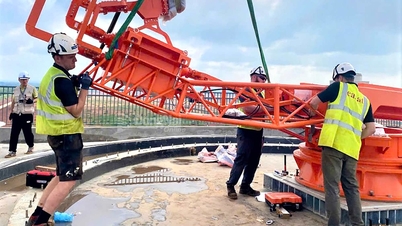







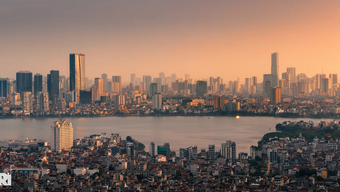














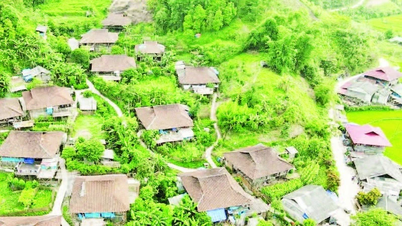

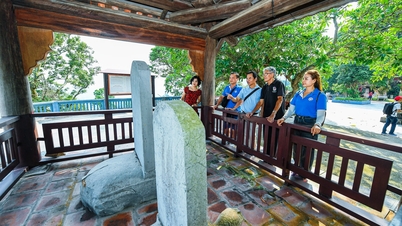
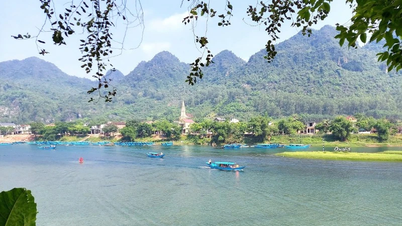






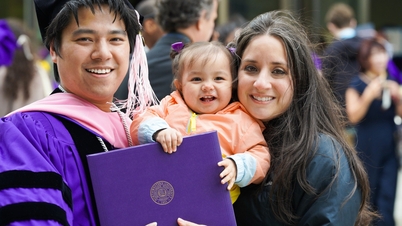





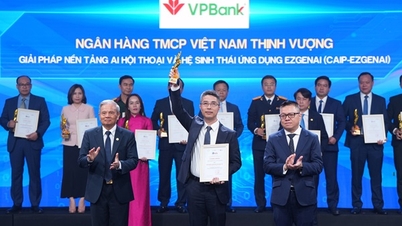












































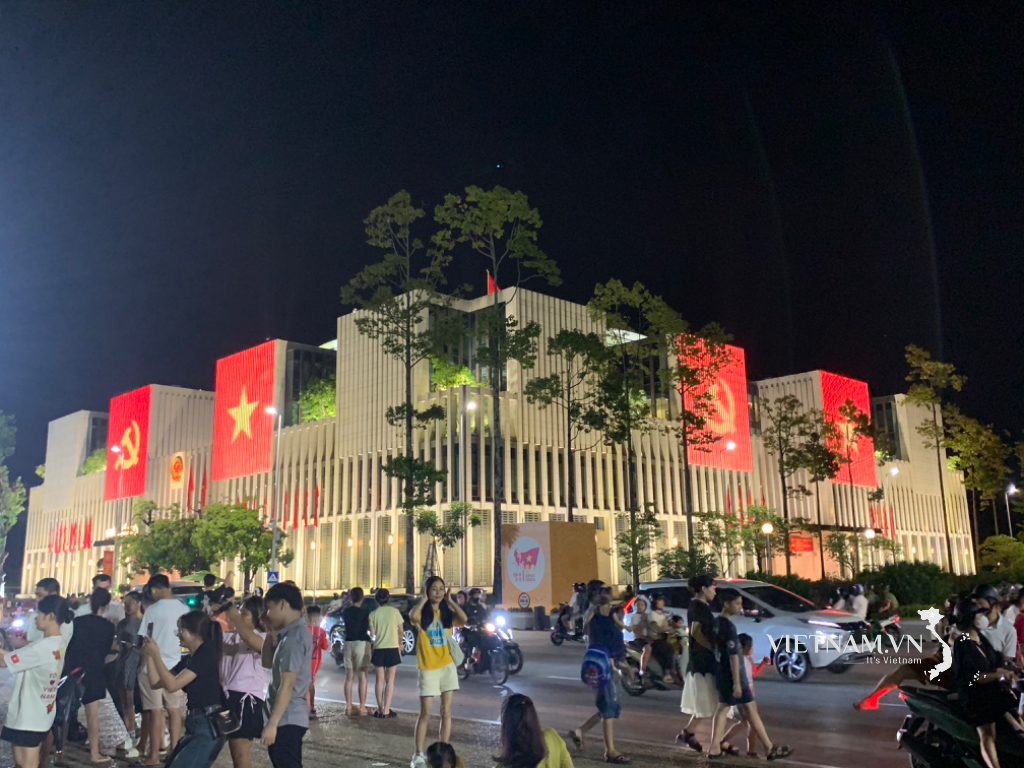
Comment (0)